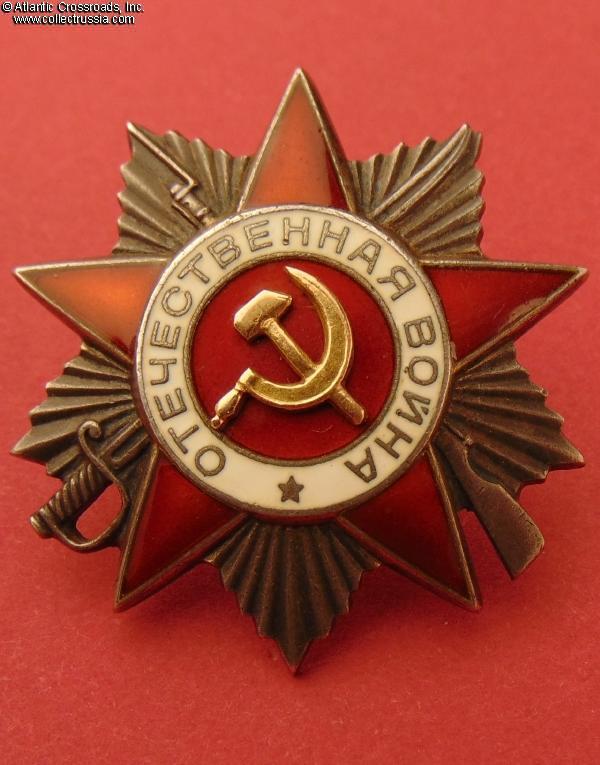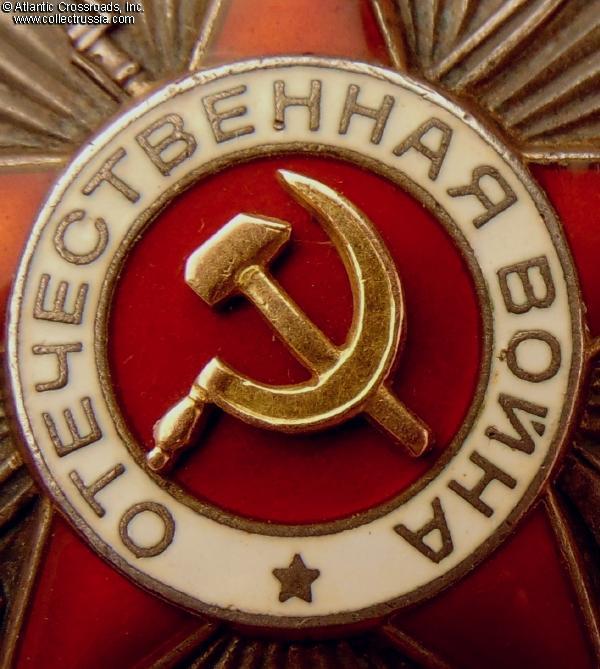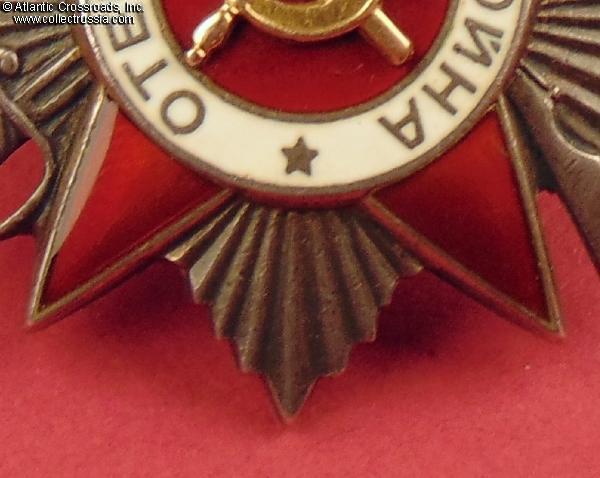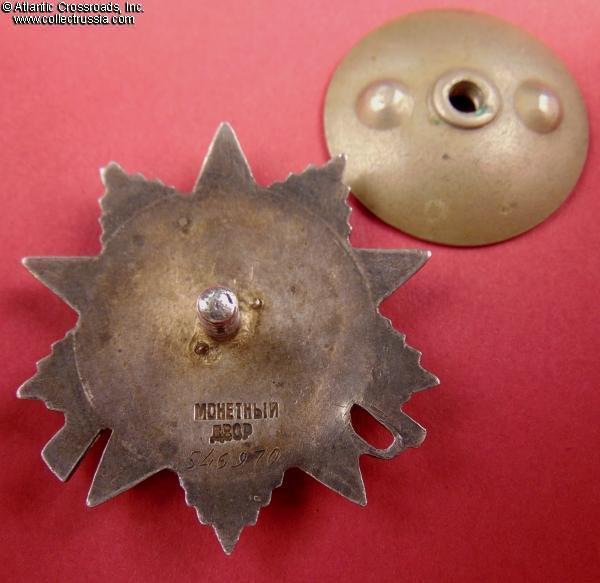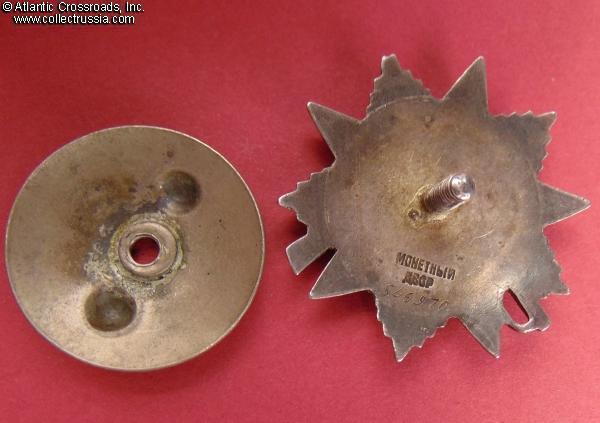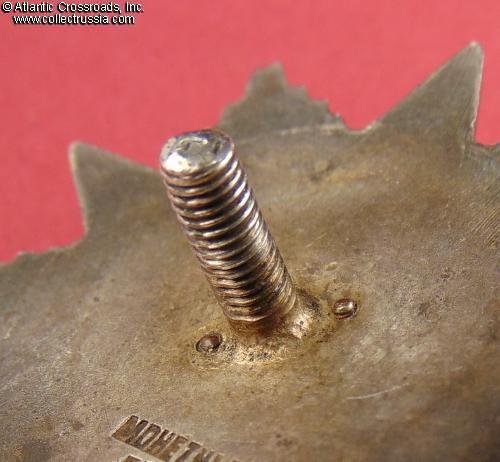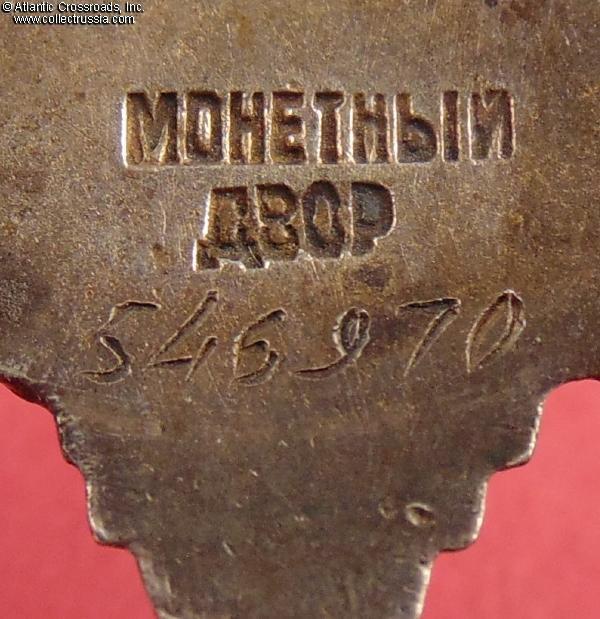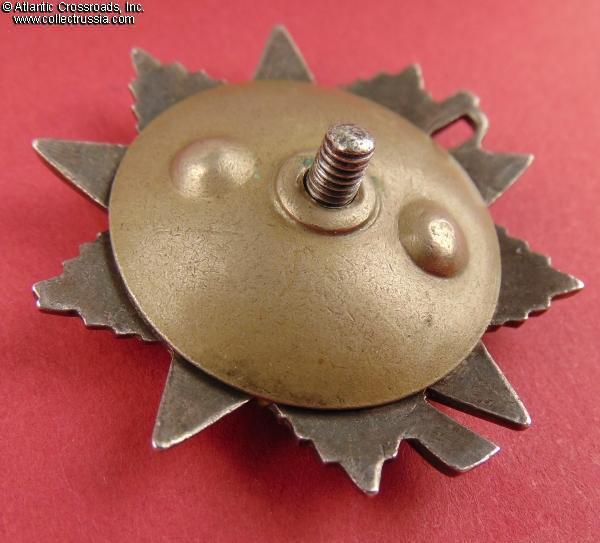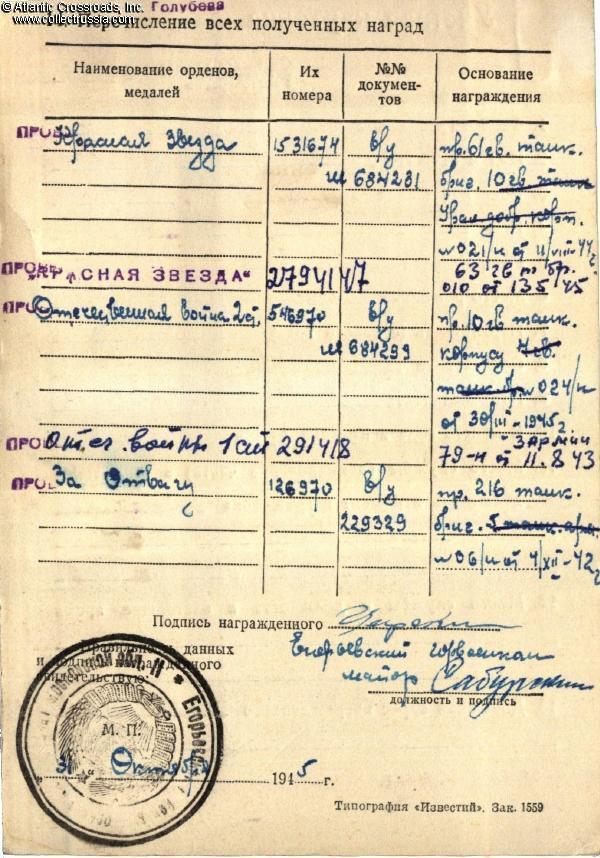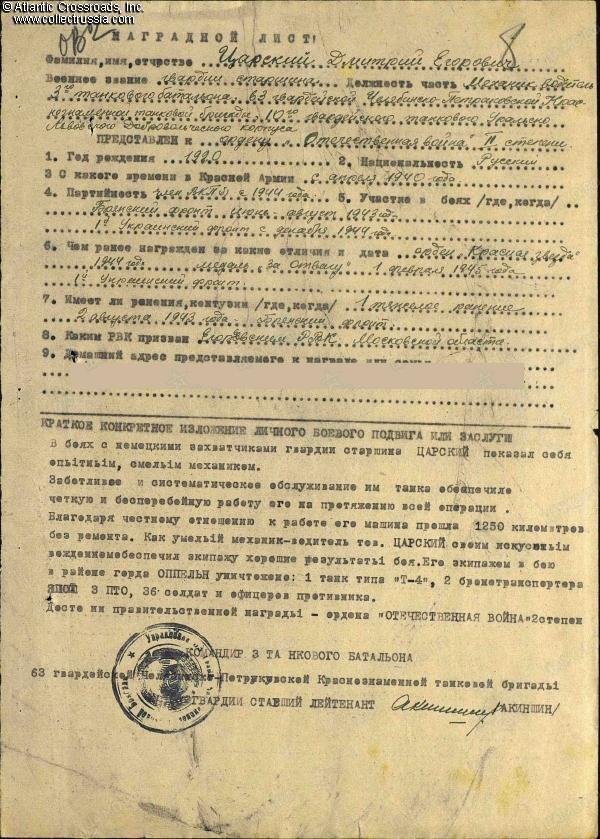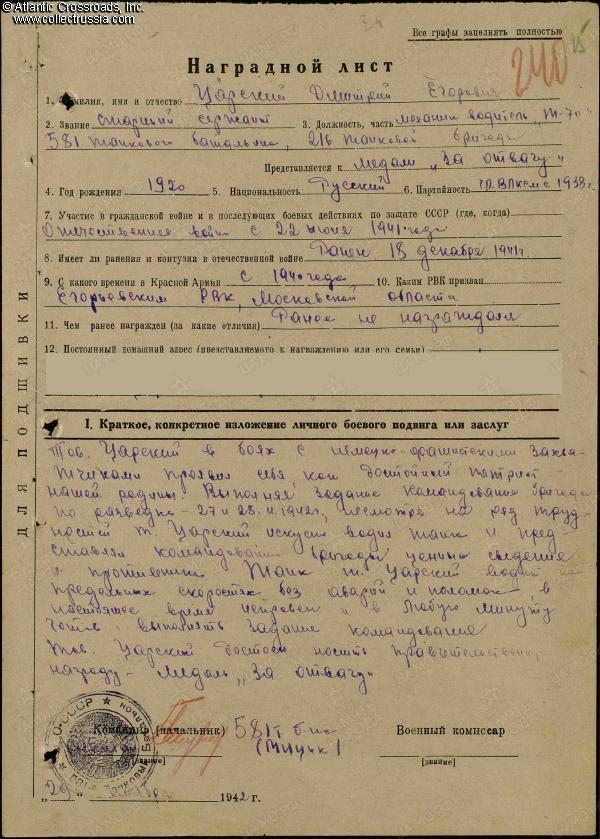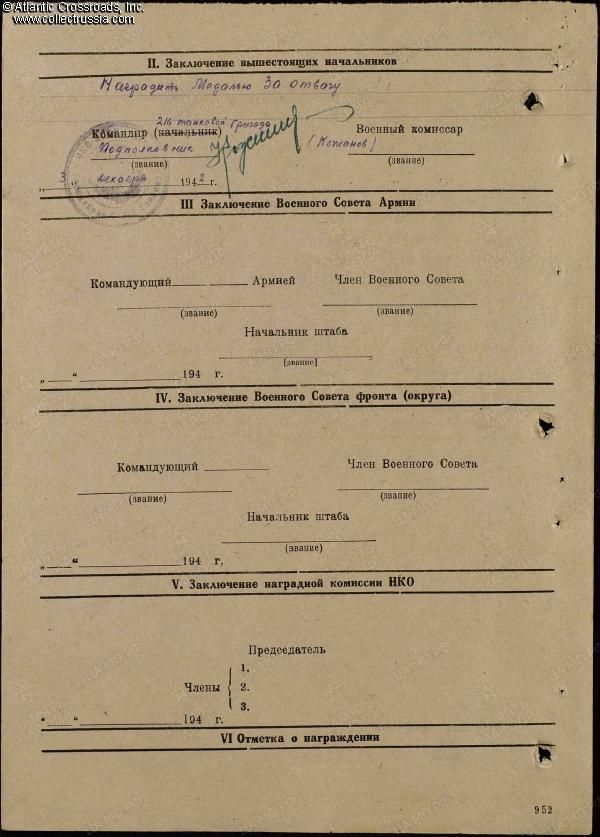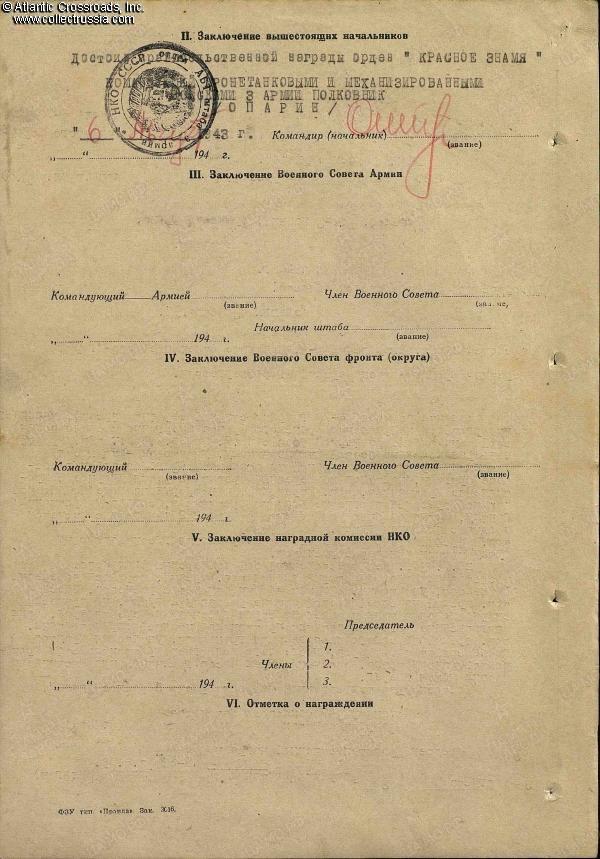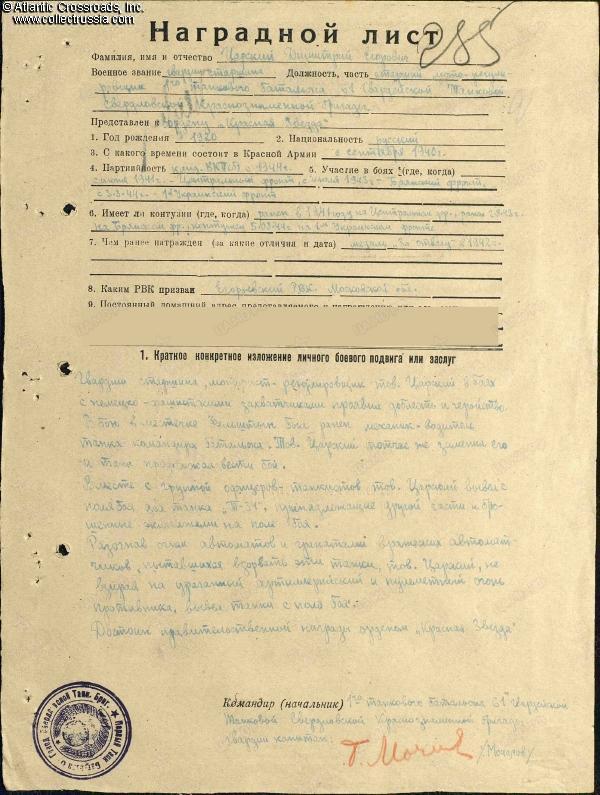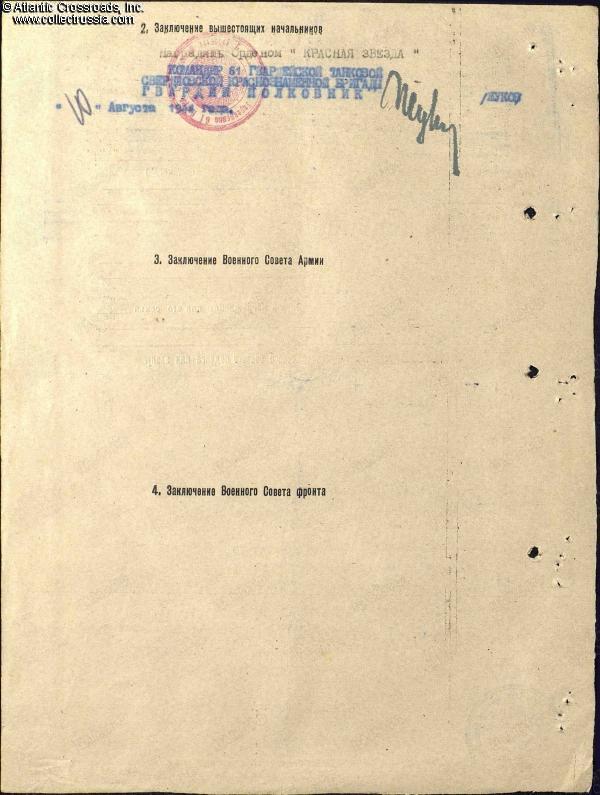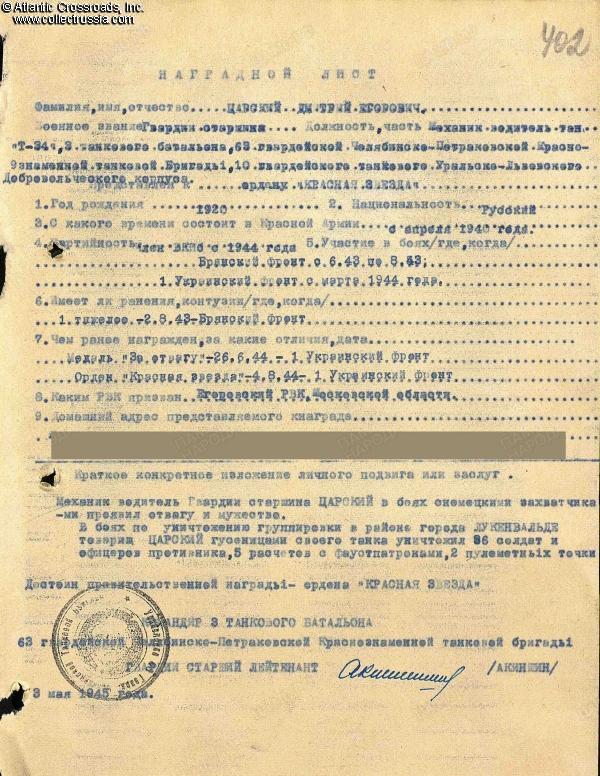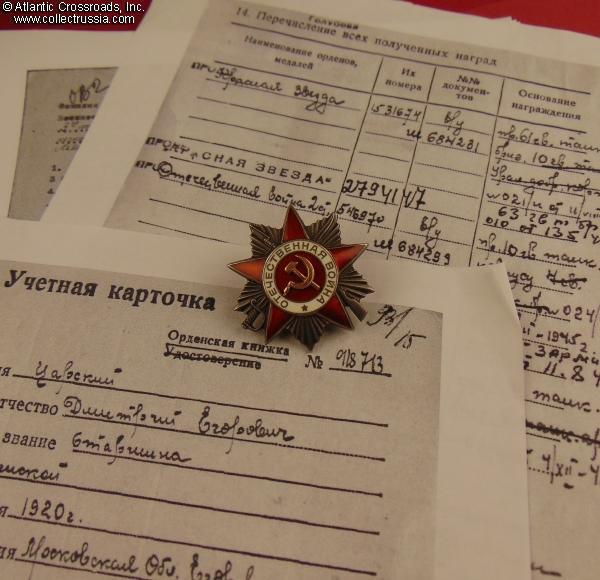Order of the Patriotic War 2nd class, Type 2, "Flatback" variation (Krasnokamsk Mint), #546970, awarded to Sergeant Major Dmitriy Tsarskiy (Дмитрий Егорович Царский), a tank driver of the 3rd Tank Battalion, 63rd Guards Tank Brigade, 10th Guards Ural Volunteer Tank Corps, 4th Tank Army, 1st Ukrainian Front.
Silver, 14 K gold (hammer and sickle emblem), enamels; measures 46.2 mm tall x 44.1 mm wide; weighs 27.4 g without the screw plate. Features a relatively flat reverse and the mint mark in straight horizontal lines. This piece is from the third series of Krasnokamsk Mint "Flatbacks", manufactured in March 1945 (according to mondvor.narod.ru). In very fine to excellent condition. The enamel appears practically perfect to the unaided eye and retains a beautiful luster. A close examination with a 10x loupe reveals a single miniscule flake at the base of the 5 o'clock arm and some microscopic contact marks to the arms throughout but no significant wear. There is a very attractive even patina to silver on both sides. The screw post is full length, nearly 13 mm, and includes an original WW2-era screw plate.
Dmitriy Tsarskiy was born in 1920 in a village of Moscow Region and drafted into the Red Army at 20 years of age, just before the Patriotic War. He was at the front lines from the first day of the war, 22 June 1941, and was wounded in December of that year. In November 1942, Tsarskiy had the rank of Sergeant and served as the driver of a T-70 light tank in the 581st Tank Battalion, 216th Tank Brigade, 5th Tank Army, Southwestern Front, engaged in the Battle of Stalingrad. At that time, the 5th Tank Army was positioned near Serafimovich on the right bank of the Don River, facing the Romanian 3rd Army and ready to attack. Once Operation Uranus, planned by Zhukov and Vasilevskiy, was launched on 19 November 1942, the 5th Tank Army quickly overran the Romanian 3rd Army which was outnumbered, poorly equipped, and stretched too thin. The lightly armed but reliable and swift T-70s were primarily designated for infantry support but were also often used for reconnaissance, and Tsarskiy distinguished himself on recon missions on 27-28 November 1942. In the commendation for the Medal for Valor, he was cited for skillful driving at maximum speed without accidents or needing help, and for bringing important information about the enemy. The medal was awarded to him on 4 December 1942, well before the end of the Battle of Stalingrad.
This medal was by far not his last wartime high decoration. The Battle of Kursk found Tsarskiy driving a T-70 tank of the 347th Tank Battalion, 17th Guards Tank Brigade, 1st Guards Tank Corps, 3rd Army, Bryansk Front, positioned on the northern flank of the salient and facing the 2nd Tank Army of the German Army Group Center. From 12 to 26 July, Tsarskiy took part in seven armor engagements, destroying German troops and equipment. On 26 July, in a skirmish for possession of the village of Apalkovo, about 35 miles southwest of Oryol, Tsarskiy's tank broke into the village, neutralized two artillery crews with its gun, and smashed with its threads two more guns and a mortar along with its crew. Over the course of the engagement, a shell hit and broke his tank's track. Enemy infantry tried to surround the tank but Tsarskiy lobbed grenades at them standing up in the turret's hatch and killed ten German soldiers. After that, he and his crew proceeded to repair the track under enemy fire. Three hours later, the tank was back in service. Commander of the 347th Tank Battalion recommended Tsarskiy for the Order of the Red Banner for his heroic actions as a part of the crew. The award was however downgraded up the chain of command to the Order of the Patriotic War 1st cl., which was bestowed upon him on 11 August 1943.
In July 1944, Tsarskiy had the rank of sergeant major and served with the a T-34 tank battalion of the 61st Guards Tank Brigade, 10th Guards Tank Corps, 4th Tank Army, 1st Ukrainian Front, engaged in the major offensive aimed at the city of Lvov in western Ukraine. In a skirmish near the settlement of Felshtyn (transliterated from Russian, not found on the modern map), the driver of the battalion commander's tank was wounded. Tsarskiy immediately took his place, and the tank remained in battle. In another episode of this offensive, Tsarskiy and a group of commissioned officers managed to save two T-34 tanks belonging to another unit and left by their crews on the battlefield. Seeing that the enemy was trying to blow up these tanks, Tsarskiy along with two of the officers dispersed the enemy soldiers with submachine gun fire and grenades, and then managed to drive the tanks off the battlefield under heavy machine gun and artillery fire. This feat earned Tsarskiy a commendation for the Order of the Red Star, which was bestowed upon him on 11 August 1944.
During the Upper Silesian offensive in March 1945, Tsarskiy was cited for excellent maintenance of his tank and great skills as a mechanic- driver. During the campaign, his T-34 had covered 1,250 km (777 miles) without repair. In the fighting for the city of Oppeln (modern-day Opole, Poland), his tank crew neutralized one Panzer IV tank, two armored personnel carriers, destroyed three anti-tank guns, and killed 36 enemy soldiers. For his outstanding service, Tsarskiy was recommended for the Order of the Patriotic War 2nd cl., which was awarded to him on 30 March 1945 by a general order of the 10th Guards Tank Corps.
Tsarskiy distinguished himself again during the Battle of Berlin, when Konev's 1st Ukrainian Front was pushing towards the Nazi capital from the south. At the time, he served as the driver of a T-34 tank in the 3rd Tank Battalion, 63rd Guards Tank Brigade, 10th Guards Tank Corps, 4th Tank Army, 1st Ukrainian Front. In fighting for the town of Luckenwalde about 35 miles south of Berlin, he used his tank as an enemy mower, crushing 36 enemy soldiers, five Panzerfaust crews, and two machine gun nests under his tank's tracks. On 13 May 1945, he was awarded with his second Order of the Red Star, his final decoration of WW2.
Dmitriy Tsarskiy retired from active duty on 31 October 1945 and returned to his native village of Korobyata in Moscow Region. It must be said that not only was he a heroic soldier - his five combat decorations were much more than a typical Soviet WW2 NCO would get - but also a very lucky man. Soviet tankers suffered terrible attrition during the war, their machines being a literal magnet for all kinds of German weapons from tanks and assault guns to Panzerfausts, Stuka dive-bombers and on occasion, even battleship artillery. For that reason and also due to low reliability of Soviet tanks, relatively few Soviet tankers survived unscathed for very long on WW2 battlefields. It was especially true for the crews of the T-70s that had inadequate armor and main gun to successfully engage contemporary German panzers.
Research Materials: b/w photocopy of the award record card and award commendations for all five wartime decorations.
Item# 46396
$395.00 Add to cart
